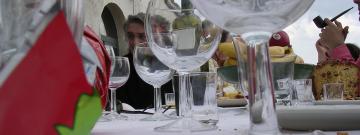|
Cooking in the Marche is deeply rooted in peasant tradition and remains impervious to the arrival of frozen bastoncini di pesce (fish fingers). Here the home cook rather than the professional chef rules and even the smartest restaurants seek to produce food just like nonna, or grandmother, used to make.
The use of fresh, top quality materials assembled with the minimum of fuss marks marchigiano food. But as dishes are strictly based on tradition and local produce, each local area has its distinctive cucina tipica.
As with any rural diet, much use is made of food gathered from the wild; funghi, game, nuts, field herbs and - the area's greatest
culinary treasure - truffles are an important feature in the Marche.
Waste, too, is frowned upon, and many of the now most fashionable dishes were first developed to use up such things as stale bread or the less
appealing parts of the pig.

Not surprisingly, the best food is still to be had in Marche homes rather than in restaurants. The arrival, however,
of tourists in smaller towns and villages has often raised the standards in local restaurants and led to the "rediscovery" of long lost traditional dishes.
The old labels ristorante, trattoria and osteria have become somewhat interchangeable in recent years;
many of the smarter, and most expensive places, call themselves osterie and take pride in reinterpreting strictly local dishes with great flair. Many restaurants also double as a pizzeria, but note that pizzas are usually
only available in the evening when the wood-fired oven is lit.
Generally, though, a ristorante will at least have a written menu and a broader choice of wines. In trattorie,
particularly in country areas, you will often have to cope with a menu rattled off at your table by the proprietor - at your blank looks a son or daughter with some English
or French will often be brought out from the back to assist.
Avoid the temptation just to order dishes whose names are familiar to you from back home - you will frequently
be missing the best the house has to offer. If you are touring in summer or early autumn, look out for posters advertising the local sagra - a festival dedicated to a
town's particular speciality where you can try the food in question in every guise imaginable. We've put a few of the more curious sagre in Marche Voyager's calendar of events.
A word of warning - Italian law requires that you always take your receipt, or ricevuta fiscale, with you from
restaurants, bars and shops. The aim is to stop sales tax fraud and plain-clothed tax inspectors do stop people outside places and can fine them if they don't have a proper receipt.
top
Eating - keep an eye out for...
Official statistics claim that marchigiani eat more meat
than any other Italians and it shows. In many country areas going out to a restaurant is basically an excuse to fuel up on enormous platters of charcoal-grilled meats - grigliata mista di carne. Relief, however, is on hand along
the Adriatic coast with some of the peninsula's best fish. Print out the Marche Voyager menu translator to help you order.
For an antipasto, mountain salt-cured ham and lonza (salt-cured fillet of pork) reign supreme. If you see it, also try ciauscolo (a soft, spreadable pork salame).
The classic primo is a generous plate of tagliatelle dressed with a sugo, or meat sauce. The region's unique pasta dish is vincisgrassi, a rich baked lasagna without
the usual tomatoes. Urbino is also famous for passatelli, strands of pasta made from breadcrumbs, parmesan cheese, and egg cooked in broth. Apart from the ever-present meat grilled alle brace, on embers, delicious
stuffed pigeons (piccione ripieno) and rabbit cooked with fennel (coniglio in porchetta) are a Marche speciality. In some areas, stewed snails (lumache) occasionally creep
on to the menu.
By the coast, particularly around Ancona, try brodetto, fish stew which must be made with 13 species of fish, no
more, no less. Thin spaghetti dressed with vongole, or baby clams, is always good here as is spaghetti allo scoglio, "on the rocks" dressed with seafood.
In the northern Marche look out for piadina, a flat, unleavened bread often served with cold meats at
roadside snack-bars. The sheep's' milk pecorino cheese is excellent here and is best eaten in the spring with young raw broad beans or fave. Look out, too, for formaggio di fossa - (a strong-flavoured cheese aged by being walled
up in limestone holes in the ground).
|